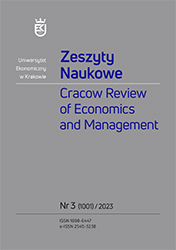The Limitations of Implementing Environmental Labelling: The Example
of Eco-Scoring
The Limitations of Implementing Environmental Labelling: The Example
of Eco-Scoring
Author(s): Joanna Katarzyna Banach, Magdalena Muradin, Janusz Turowski, Magdalena WojnarowskaSubject(s): Business Economy / Management, Agriculture, Energy and Environmental Studies
Published by: Wydawnictwo Uniwersytetu Ekonomicznego w Krakowie
Keywords: environmental management; product environmental footprint; environmental labelling; Eco-Score;
Summary/Abstract: Objective: To identify potential limitations for the development of Polish enterprises resulting from the need to label dairy products. The focus is on Eco-Score labelling for a selected product from the dairy industry.Research Design & Methods: The article presents the calculations of the Eco-Score index for Polish mozzarella cheese (125 g) made from cow’s milk and produced under a discount store’s brand name. On the basis of a case study, an analysis was done with the Eco-Score for mozzarella cheese produced in France. The Eco-Score is the reference value (benchmark) for calculating the Single Score based on PEF methodology.Findings: Out of ten mozzarella cheeses available on the Polish market, two of them were classified as category C products (Eco-Score 53 and 58 Pt), indicating that their impact on the environment was moderate. The remaining eight cheeses fell into category D, meaning they had a high impact.Implications / Recommendations: In the case of Eco-Score, Polish products are assigned a lower category at the outset due to their country of origin and the government’s environmental policy. In turn, when it comes to labelling based on product environmental footprint (PEF) rules, the increased environmental burden resulting from the Polish energy mix may pose a challenge when calculating the environmental footprint of a product and comparing it to the designated benchmark.Contribution: The conclusions from the article may be helpful for industry management in understanding the benefits and limitations of environmental labelling of dairy products and their voluntary use.
Journal: Zeszyty Naukowe Uniwersytetu Ekonomicznego w Krakowie
- Issue Year: 1001/2023
- Issue No: 3
- Page Range: 85-103
- Page Count: 19
- Language: English

